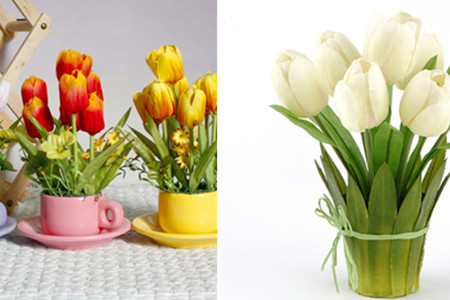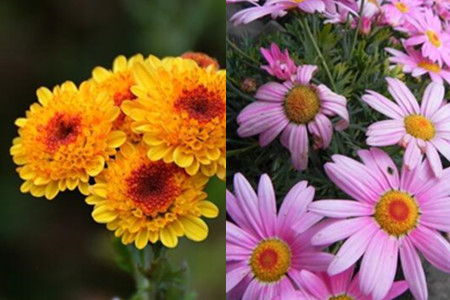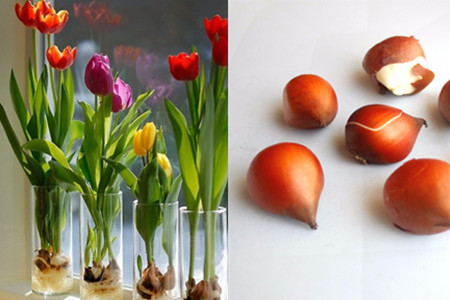How to grow tulip seeds to teach you three steps to grow healthy plants

For a long time, people like to decorate the courtyard, street or home with all kinds of plants, especially those with flowers, the more common of which is tulips. This is a very special flower, its flower shape is like an inverted lampshade, and the color is also divided into many kinds, some even a flower multi-color, so this kind of flower has always been very popular and popular.
In addition, the seed of this flower is also very special, it is said that it is the seed, in fact, it is its root, and its shape is very similar to the garlic we often eat. However, few people really understand how the seeds of this plant are planted. Next, let's introduce its planting method.
1. Select seeds
If you want to grow strong plants, you should pick out seeds that can sprout. When choosing, friends should choose those that are a little harder and shiny, otherwise it will be very difficult to survive.
2. Plant the seeds in the soil
Unlike most seeds, this kind of seed does not need to be buried in the soil, so it is difficult to sprout. Friends should insert them in the soil, let their tops exposed, and keep their exposed parts at 1/2.
3. Location of placement
Many people think that the pot where the seeds are buried should be placed in a sunny place, but in fact, this is not correct, because it will cause damage to the seeds and it will be difficult to germinate again. Friends should put the basin in a place away from the light so that it will not be affected.
The steps mentioned above are easy to operate, and once done, you only need to wait a week or two to see the green buds emerge. Of course, the replenishment of water should not be forgotten during this period.
How to plant daisy seeds _ how to raise daisies?
Daisy is a very popular flower plant, its shape looks very lovely, and very likable. It has very high ornamental value and medicinal value, and is often farmed in the garden and windowsill, so as to enrich people's spare time life and broaden people's horizons. It is a very popular flower plant. But love does not mean how to grow daisies and how to raise daisies. If you want to know, follow the editor's steps to take a look at how to plant daisies and how to raise daisies. [how to raise daisies] Daisy is a perennial herb belonging to the genus Compositae. It is relatively hardy and is often used as a biennial plant. It is usually carefully planted in the world from August to September, so that you can enjoy the beautiful and lovely East China 12-14 weeks after sowing. When sowing, you should use loose, fertile and breathable soil, which is proudly covered with vermiculite. Such a thin missing seed is the best. Generally speaking, the way of sowing daisies is used when sowing daisies, because the seeds are relatively small and are not particularly suitable for sowing on demand. Transplant can be carried out when the seedling has 2-3 solid leaves, keeping the temperature at 18-20 degrees Celsius and humidity at 80-90%, so that it can germinate five days after sowing. [how to plant daisy seeds] when daisies are planted, they usually use the way of sowing, and they can also use ramets to propagate. Sowing is generally carried out from August to September, using open-field seedbed and seedling tray to sow seeds. The soil needs to be fine and smooth, and there should be plenty of light when sprouting. Generally, the seeds germinate in a week to half a month after sowing, and the germination is relatively neat at this time. After 12-14 weeks of sowing and flowering, the life span of the seeds can be maintained for more than 3 years. If the planting method of ramet is adopted, the ramet should be carried out after the plant is aged after anthesis. First, daisy seed planting-pot: choose daisies with better root development, which is more resistant to transplant, and should grow 2-3 true leaves to transplant seedlings, and 4-5 true leaves should be planted. The best distance between plants is 20-25cm.
Second, daisy seed planting-soil: choose the soil rich in organic matter, loose and fertile, and good drainage, and can also be cultivated with rotten leaf soil, garden soil, rice bran ash and perlite. Third, daisy seed planting-temperature: daisies like to grow in a cool environment, and the temperature should be kept at 7-15 degrees Celsius, and the seedlings should be vernalized at 5-10 degrees Celsius, so as to promote germination and differentiation and provide uniformity of flowers. let it have a good appreciation value. Fourth, daisy seed planting-light: daisies like to grow in a sunny environment, especially during the growth period, to give sufficient sunlight, if not enough sunlight will cause the plant to grow and prolong the flowering period. Shading and cooling should be carried out in the summer, so that it is safe to pass the summer.
Fifth, daisy seed planting-watering: daisies are not resistant to moisture, so it is necessary to pour some fertilizer and water after emergence to promote the growth of plant branches and leaves. As the temperature decreases, the amount of water should be reduced, and sufficient water should be given when the pre-cold air is attacked to keep the basin soil moist and prevent it from being cracked by dry freezing. The amount of water should be increased after spring to promote leaf growth and flowering. If the amount of water is too much, it will cause scorch or yellowing of leaves, or even plant withering. Sixth, daisy seed planting-fertilization: daisies are more fertilizer-tolerant, fertilizer and water management should be carried out after germination to promote the growth of seedlings. In the cold winter, it is necessary to reduce fertilization and improve its cold resistance. Fertilizing more in spring, applying nitrogen, phosphorus and potassium mixture every half a month to promote flowering more luxuriantly. Seventh, daisy seed planting-pruning: if the daisies bloom prematurely, they should be picked in time, and the residual flowers should be picked during the flowering period, so as to reduce the nutritional consumption of the plants and make the flowers bloom more beautifully. 8. Daisy seed planting-prevention of diseases and insect pests: daisies will have the following hazards of bacterial black disease, black spot, short-forehead negative locust and small green grasshopper, and light yellow and purple-brown spots will appear on the leaves, which will seriously change against dark brown. In case of these situations, it is necessary to stop in time to prevent the spread of diseases and pests. Conclusion: the above is the introduction of how to plant daisy seeds and how to raise daisies. The introduction of Xiaobian is more detailed. I hope to give you more help when raising daisies. Thank you for your appreciation.
More information about how to grow flowers, how to raise Yushu, how to raise tulips, what does camellia represent, how to raise pineapple flowers
How long does the tulip bloom? how do the tulips blossom?
Tulip is a perennial herb, and it is also one of many people's favorite flowers. when the tulips are in full bloom, many people will go to the garden area to enjoy it. With the weather getting warmer, many people want to go to the garden area to enjoy the beauty of the flowers. Tulip is a very famous flower, with many varieties and colorful colors, and has a very good ornamental and embellishment effect. Many people like to plant tulips at home to beautify their homes. So, how long is the flowering period of tulips?
First, about tulips
The symbolism of tulips has something to do with its ability to become the national flower of the Netherlands. The period from 1634 to 1637 was known as the "tulip mania" in Dutch history. During this crazy period of tulip investment, the number of tulips in the financial market exceeded the actual number of tulips planted. Therefore, at the beginning of the 19th century, only 130 acres of tulips were planted in the Netherlands. By the middle of the 20th century, it had grown to more than 20,000 acres, accounting for more than 80% of the world's total tulip exports. It was marketed in 125 countries and was known as the "flower queen of the world".
Due to the climate of the Mediterranean, tulips adapt to cold and humid winter and dry and hot summer, while purple tulips are characterized by dormancy in summer, rooting and sprouting in autumn and winter, but not unearthed. After winter low temperature, around the first ten days of February (the temperature is above 5 ℃), they begin to stretch and grow to form stems and leaves, and bloom from March to April. The suitable temperature for growth and flowering is 15-20 ℃. Flower bud differentiation is carried out during summer storage when the bulbs are dug up from the basin when the stems and leaves turn yellow. The optimum temperature for differentiation was 20-25 ℃, and the highest was not more than 28 ℃.
The three students who cultivated purple tulips for the first time carried out the experiment based on the knowledge of chemistry and biological sciences. The students prepared a special nutrient solution for tulips, and after months of cultivation, they finally cultivated indigo tulips, the color closest to purple in nature. It is very rare for the experiment to get this result.
Second, the flowering period of tulips
Tulip belongs to the family Liliaceae and belongs to the genus Tulip. Herbs perennial, bulbs oblate-conic, with brown strands. There are many cultivated varieties, up to more than 8000. The flower types are cup-shaped, bowl-shaped, egg-shaped and spherical-shaped. The suitable temperature for its growth and flowering is 15-20 ℃, and it blossoms from March to April every year. The flowering period of tulips is more than 60 days from sowing to flowering, and some are only about 45 days. The flowering time is from March to May. The flowering period of tulips depends entirely on the temperature. If the temperature is high, the flowering period is very short, about a week at most. If the temperature is low, the flowering period of tulips is longer, usually about two months.
Tulip is a world-famous bulb flower, or an excellent variety of cut flowers, the flower branches are strong and straight. The leaves are simple and elegant and beautiful, and the lotus-like flowers are dignified and lovely. The flowering period of tulips is when tulips bloom in mid-and late July. It takes more than 60 days from sowing to flowering, some only about 45 days. The flowering time is from March to May. The flowering period of tulips depends entirely on the temperature. If the temperature is high, the flowering period is very short, about a week at most. If the temperature is low, the flowering period of tulips is longer, usually about two months.
The optimum temperature for tulip growth and flowering is 15-20 ℃. Flower bud differentiation is carried out during summer storage when the bulbs are dug up from the basin when the stems and leaves turn yellow. The optimum temperature for differentiation was 20-25 ℃, and the highest was not more than 28 ℃. The flowering period of tulips is uneven, with some blooming in early March and some at the end of April. In short, the flowering period of tulips is generally from late March to early May. In addition, watching tulips at 7 o'clock in the morning is the most beautiful moment, particularly elegant and refined, fresh and meaningful, people never get tired of seeing them.
How to raise tulips and blossom
1. Methods of reproduction. It is commonly used to divide balls and sow and propagate. ① propagated in separate bulbs. After growing in one season, the mother ball planted in that year can produce 1-2 large bulbs and 3-5 small bulbs at the same time. It can be planted separately according to the size of the seed bulb, the big bulb can blossom in the same year, and the small bulb can blossom for 1 ~ 2 years.
② sows and propagates. The sowing and propagation of tulips are mostly used to cultivate new varieties. The seeds are harvested before the capsule is ripe and dehiscent, and the seeds are stored and sown indoors in October. Keep it moist, sprout in the following spring and blossom for about 3-4 years.
2. Cultivation and management. ① strictly controls the temperature. The optimum temperature for the growth period of tulips is 5: 20 ℃, the optimum temperature is 15: 18 ℃, and the growth temperature of plants should be kept at 0: 25 ℃. The growth temperature of tulip root system should be above 5 ℃ and below 14 ℃, especially about 10 ℃. When the optimum temperature for flower bud differentiation was more than 35 ℃, flower bud differentiation would be inhibited. In addition, tulips have strong cold tolerance, can withstand a low temperature of 35 ℃ in winter, and begin to grow when the temperature is kept above 8 ℃.
② water management. Excessive irrigation should be avoided in the process of cultivation, but more water should be needed within one week after planting, and the water demand should be reduced after germination, especially during flowering, and watering should be done "a small amount of water for many times". If it is too dry, fertility will be significantly delayed, and the air humidity should be kept at about 80% during the growth of tulips.
③ light condition. When the bulb germinates, the elongation of the flower bud is inhibited by sunlight. Therefore, it must be deeply planted and moderately shaded to prevent direct sunlight from adversely affecting the growth of the bulb.
④ soil and fertilization. The sandy loam is better, and the soil pH is neutral and alkaline. Tulips prefer fertilizer and should be fully fertilized before planting. Generally, dry chicken manure or rotten compost is used as base fertilizer and fully irrigated, and carefully ploughed and raked 2-3 days before planting to ensure that the soil is loose.
⑤ pest control. The main diseases of tulips are Sclerotinia sclerotiorum, Botrytis cinerea and broken petal disease. First of all, the prevention and control method is to select virus-free seed balls as far as possible, disinfect the soil and seed balls, burn disease balls and diseased plants in time, and then spray 5% benzoate wettable emulsion 2500 times every half a month.
Finally, the above is the introduction of the relevant knowledge about tulips, looking at how long the tulips bloom, I hope that friends who have needs in this regard can help. Friends who want to watch tulips, do not miss the best time to watch tulips!
- Prev

Appreciation of the growth habits of small chrysanthemum bonsai
Chrysanthemums like short sunshine and have strong cold resistance, so the frequency of watering should not be too frequent. Chrysanthemums are cold-tolerant, and their roots can not freeze to death in the ground in cold winter. Small chrysanthemum bonsai protects against radiation, purifies the air and beautifies the environment.
- Next

The method of hydroponic culture of tulip bulbs can grow better by changing water in time.
Tulip is a plant of the genus Tulip of Liliaceae. it is the national flower of Turkey, Kazakhstan and the Netherlands. Tulip is a long-sunshine flower with a sexual preference to the sun and shelter from the wind. Its planting methods are divided into soil culture and water culture. Let's introduce how to do it in water culture.
Related
- Fuxing push coffee new agricultural production and marketing class: lack of small-scale processing plants
- Jujube rice field leisure farm deep ploughing Yilan for five years to create a space for organic food and play
- Nongyu Farm-A trial of organic papaya for brave women with advanced technology
- Four points for attention in the prevention and control of diseases and insect pests of edible fungi
- How to add nutrient solution to Edible Fungi
- Is there any good way to control edible fungus mites?
- Open Inoculation Technology of Edible Fungi
- Is there any clever way to use fertilizer for edible fungus in winter?
- What agents are used to kill the pathogens of edible fungi in the mushroom shed?
- Rapid drying of Edible Fungi

